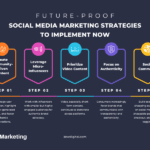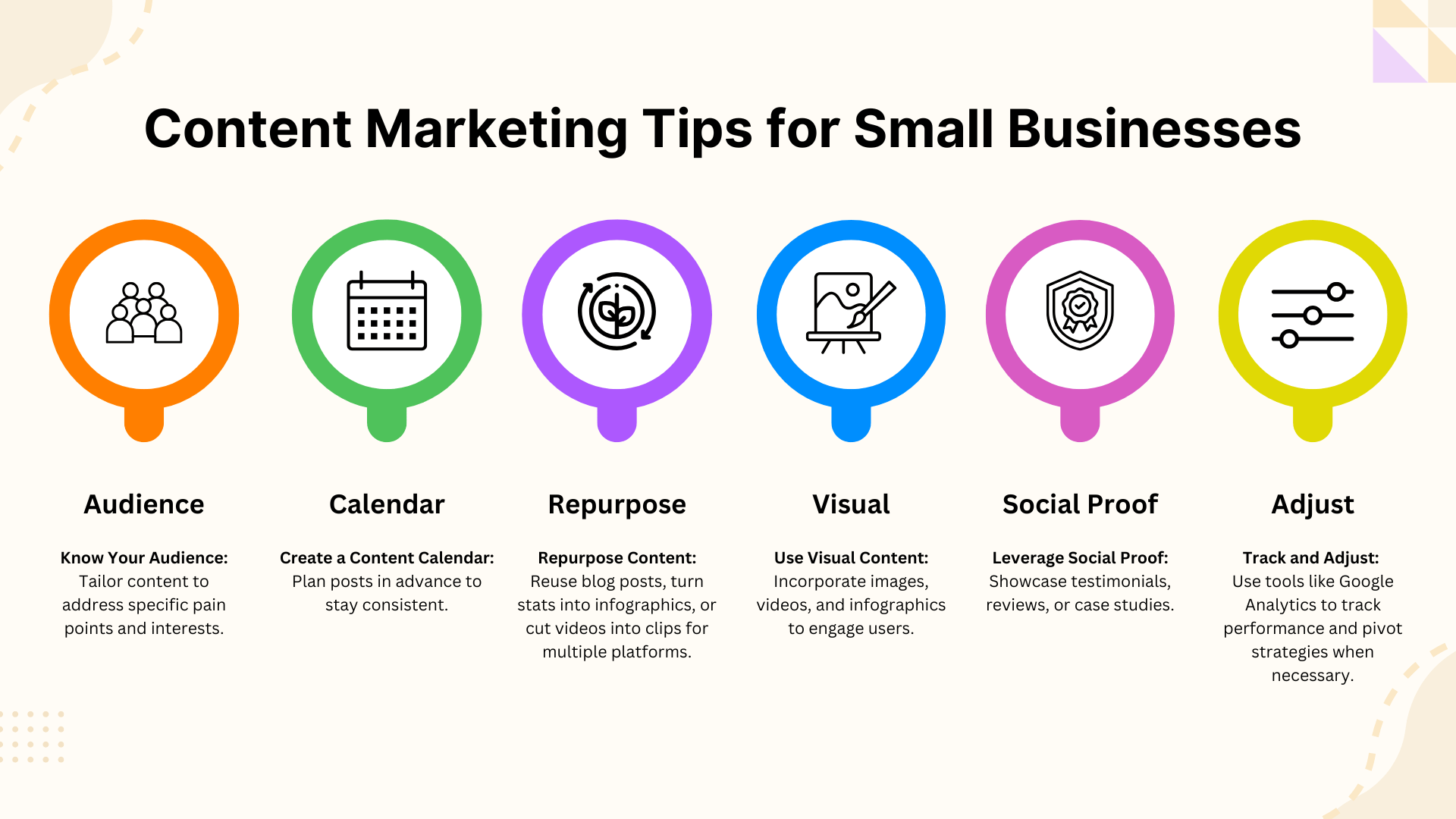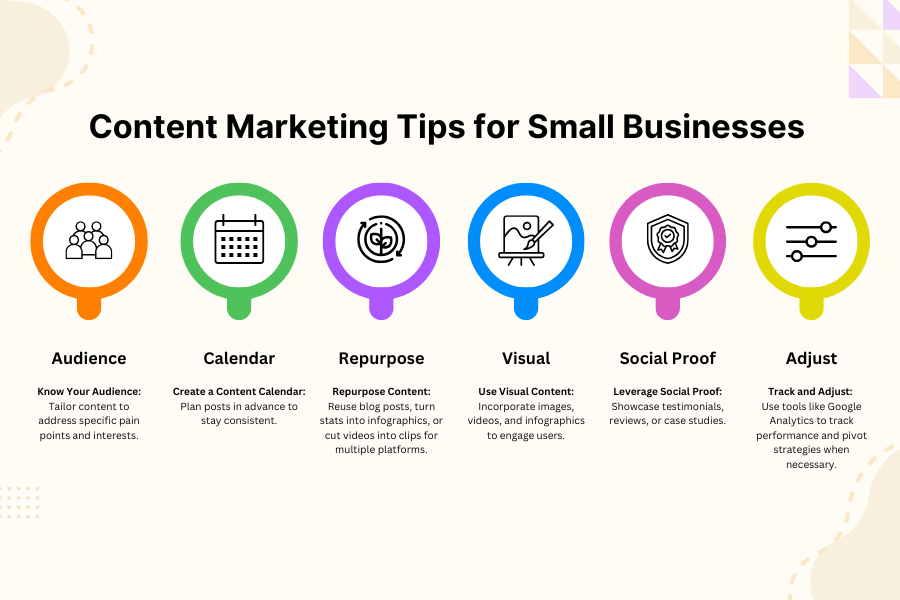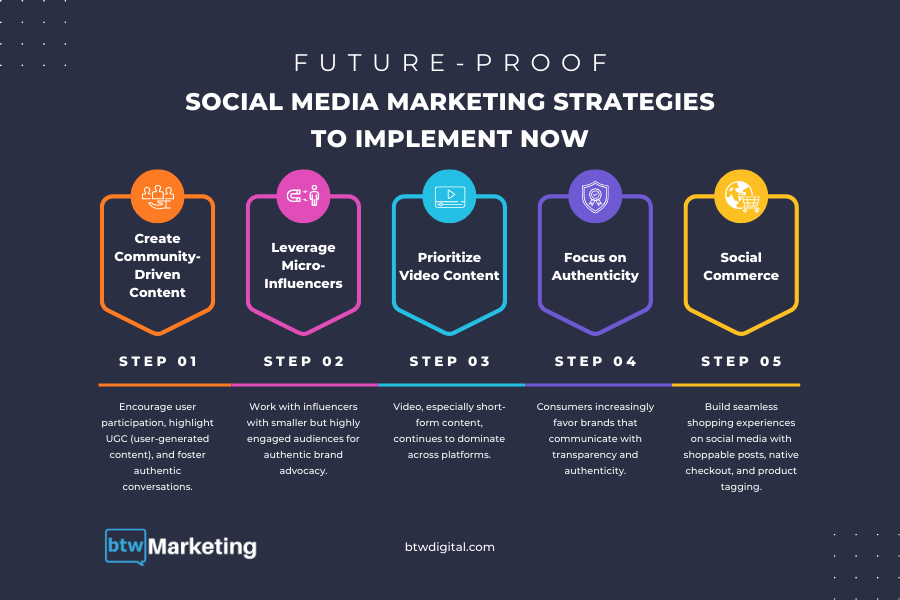
Future-Proof Social Media Marketing Strategies
October 27, 2024
Top AI Tools for Digital Marketing Success
October 28, 2024Content Marketing Tips for Small Businesses

Content marketing can seem overwhelming for small businesses with limited time and resources. However, by focusing on key strategies, even the smallest business can enhance its online presence, engage its target audience, and drive growth. Here are six essential content marketing tips to help your small business make the most of its marketing efforts.
1. Know Your Audience
Creating content without understanding your audience is like shooting in the dark. Every piece of content you develop should address your audience's specific needs, preferences, and pain points. To effectively "know your audience," consider conducting audience research:
- Demographics: Age, gender, occupation, and location are all essential for crafting targeted content.
- Behavioral Patterns: What are their online habits? Do they prefer reading blogs, watching videos, or engaging with social media posts?
- Pain Points: Identify the problems they face that your products or services can solve.
Understanding these factors will allow you to create personalized content that resonates with your audience. Audience research tools like Google Analytics, social media insights, and surveys can offer valuable information about who your customers are and what they care about.
Learn More: Know Your Audience in Content Marketing
2. Create a Content Calendar
Consistency is critical in content marketing. A content calendar helps you organize and plan your content in advance, ensuring that you’re posting regularly across all platforms. Here’s why a content calendar is important:
- Improved Organization: A calendar helps you visualize your content plan, ensuring that you're not scrambling to create content at the last minute.
- Content Variety: By mapping out your content, you can plan for a mix of blog posts, social media updates, videos, and newsletters, keeping your audience engaged with different formats.
- Seasonal Relevance: A content calendar allows you to plan around holidays, product launches, or industry events to make your content timely.
Use tools like Trello, Google Sheets, or dedicated content calendar platforms to streamline your scheduling process.
Learn More - How to Create a Content Calendar for Your Small Business
3. Repurpose Content
Creating fresh content can be time-consuming, especially for small businesses with limited resources. That's where repurposing comes in. Repurposing content involves taking an existing piece of content and transforming it into a different format. Here are a few ideas:
- Blog to Infographic: Turn a data-heavy blog post into a visually appealing infographic.
- Video to Blog Post: Transcribe your videos into blog posts to capture readers who prefer text content.
- Social Media Snippets: Take quotes or highlights from a longer piece of content, like a blog or podcast, and use them as social media posts.
Repurposing allows you to get more mileage out of your content while reaching a broader audience across multiple platforms.
Learn More - How to Repurpose Content for Maximum Reach
4. Use Visual Content
Visual content is a powerful tool for capturing attention and conveying complex information quickly. Studies show that visual content can increase engagement and retention rates, making it an essential part of any content marketing strategy. Types of visual content you can use include:
- Infographics: Infographics simplify complex data and make it more digestible for readers.
- Videos: Video content can explain your products, share customer testimonials, or tell your brand story in a more engaging way than text alone.
- Images: High-quality images can break up large blocks of text and make your content more attractive.
Using visuals makes your content more shareable, especially on social media platforms where images and videos perform better than plain text posts.
Learn More - Why Visual Content is Essential in Marketing
5. Leverage Social Proof
Social proof is a psychological phenomenon where people look to others to determine how they should behave. In marketing, leveraging social proof means showcasing how other customers have benefited from your products or services. Here’s how you can use social proof effectively:
- Customer Testimonials: Share reviews or feedback from satisfied customers to build trust with new prospects.
- Case Studies: Showcase detailed case studies of how your products or services solved real problems for clients.
- User-Generated Content (UGC): Encourage your customers to share photos or videos of themselves using your products, and feature their content on your website or social channels.
Social proof increases credibility and provides potential customers with the confidence they need to choose your brand.
Learn More - How to Leverage Social Proof in Marketing to Build Trust
6. Track and Adjust Performance
No content marketing strategy is complete without performance tracking. By analyzing your content’s performance, you can identify what’s working and what needs improvement. Here are key metrics to track:
- Engagement Rates: Monitor likes, shares, comments, and other forms of interaction to gauge how well your content is resonating.
- Conversion Rates: Track how many readers or viewers are taking desired actions, like signing up for your newsletter or purchasing a product.
- Traffic Sources: Use tools like Google Analytics to see where your traffic is coming from (social media, search engines, referrals, etc.).
Regularly assessing your performance allows you to refine your content strategy and make data-driven decisions to enhance future results.
Learn More - How to Track and Adjust Content Marketing Performance








